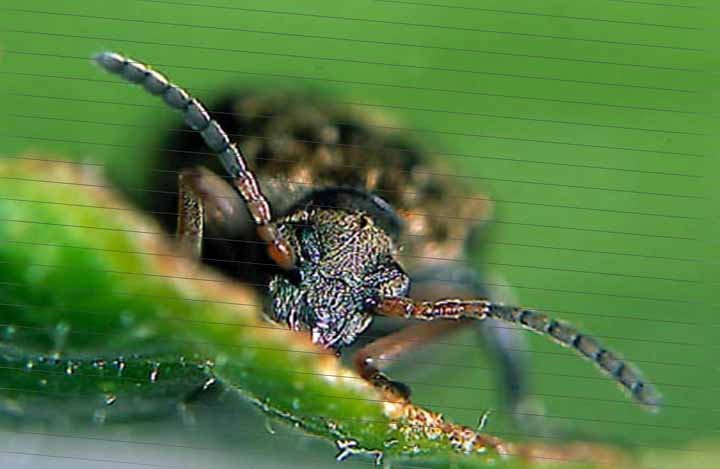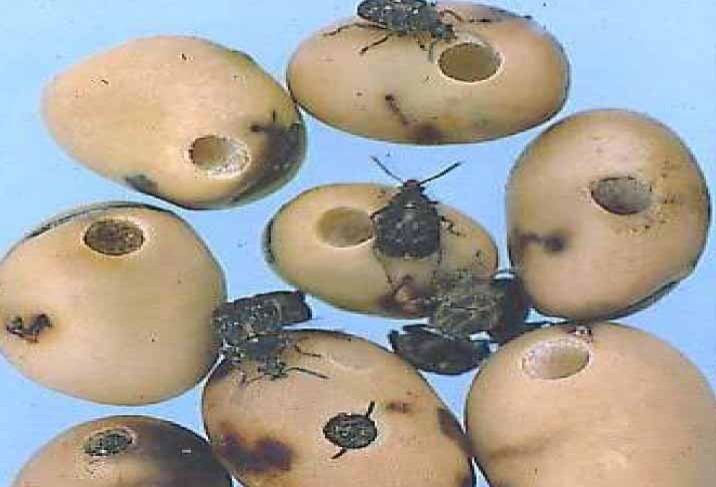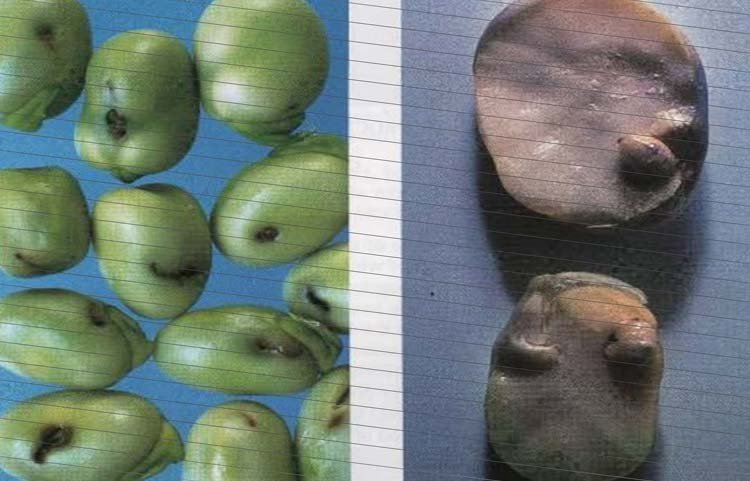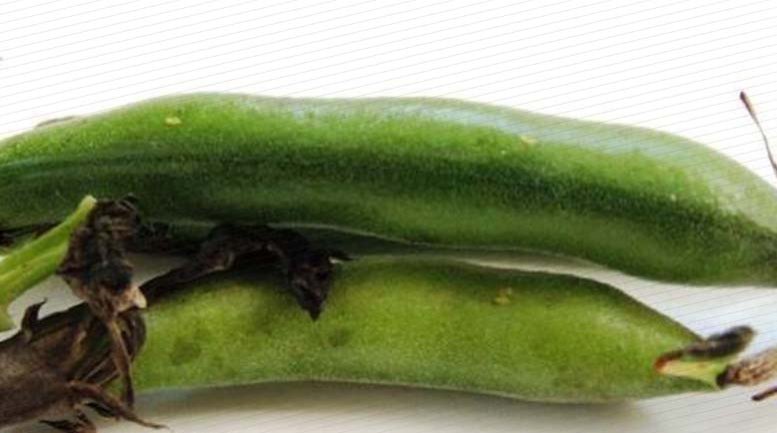 Full
FullGuide »

January 2025
Bruchid beetle in field and broad beans
The bean bruchid beetle is now widespread in all varieties of winter and spring field beans and broad beans in many parts of England. Damage to field beans is characterised by a circular hole in the seed where the adult beetles have emerged (Figure 2). In broad beans, the shelled beans may be blemished or infested with the immature larvae. In field beans, the most significant effect of the damage is to reduce the value of the crop for the human consumption export trade, or for seed. The presence of damage or larvae in broad beans makes them unacceptable for processing.
DAMAGE
Many varieties of spring and some winter beans are exported to the Middle East for human consumption. The damage is apparent after the adults have emerged, but beans may also contain unemerged pupae or adults. High levels of damage or infestation are unacceptable for most export outlets. For seed purposes, damage at low levels may not be so serious, althoughat high levels, germination of the seed may be significantly reduced. In broad beans, the entry hole of the newly hatched larvae is visible as a small hole or cut in the seed coat of the shelled bean (Figure 3). This may darken after vining. If the beans are cut open, the immature larva can be found feeding within the seed (Figure 3). Blemished or infested beans in a load may lead to crop rejection by the processors.
 Figure 1
Figure 1
DESCRIPTION AND LIFE CYCLE
There are many species of bruchid seed beetles worldwide, and the bean seed beetle (Bruchus rufimanus) is a species endemic in the UK. Unlike many other tropical species, it has only one generation each year and does not multiply in stored produce.
The adult beetle (Figure 1) is 3.5 - 4.5 mm long, oval, black or dark brown in colour with small, grey flecks along the wing cases. A characteristic of bruchid beetles is that the wing cases do not extend to cover the abdomen completely and the hind pair of legs appears to be longer than the other two pairs. The larvae are found inside seeds. They are white, segmented, fleshy grubs, 3 - 4 mm long when fully
grown, have a light brown head with small legs on the forward three segments.
Adults fly to beans from their overwintering sites, surrounding hedgerows and standing trees, during April and May and after feeding for about two weeks on pollen, eggs are laid on the surface of developing pods. Pods which are 3 - 5 cm long are favoured for oviposition. Eggs are laid singly and are translucent, cigar-shaped, 0.5 mm long with a flattened irregular edged base and are fixed to the pod surface (Figure 4). Egg laying is often concentrated on pods set on the lower
third of the plant. After a few days, the larvae hatch and bore through the pod wall into the developing seed. Development continues inside the seed where the larva
feeds within a circular chamber just beneath the seed coat. In field beans, when fully grown, the larva pupates, and this coincides with the time that seed is mature and dry. After pupation, the adult then bites through the seed coat, leaving a circular hole in the bean.
Many beetles emerge before harvest, but often emergence takes place in store, especially if there is a late harvest and the moisture content of the seed is high. Some smaller holes are made by the emergence of the parasitic wasp, Triaspis luteipes, which parasitises the beetle larvae.
 Figure 2
Figure 2
CONTROL IN STORE
Merchants may not accept field beans for any purpose with live beetles present. Although B. rufimanus does not re-infest stored beans, infested beans are best left on the farm until the emergence period is over, which in most years is complete by late October. If, however, this is not possible, then fumigation may be considered. Beetles may be killed by a recommended grain storage insecticide. However, it is unlikely to control pupae or adults which have not yet emerged. Fumigation of beans intended for seed is possible.
 Figure 3
Figure 3
CONTROL IN THE FIELD
Control of larvae as they hatch from the eggs is not possible because they penetrate the pod immediately beneath the egg case. A reduction of damage must be achieved by reducing egg laying. The timing of the spray is therefore critical. During flowering, crops should be examined for adults. This can be done by
tapping the flowering stems into the hand or a small flat box.
Certain products can be used in field and broad beans during flowering and have been shown in historic trials to reduce the level of damage. This includes lambda-cyhalothrin. In broad beans several products containing lambda-cyhalothrin are available under Extension of Authorisation for Minor Uses. More recently, insecticides have been less effective, and it is thought that this may be due to insecticide resistance. To improve control, work in LINK (DEFRA)* and Innovate UK** research projects indicated that more reliable control of the pest was
achieved by combining spray timing with temperature thresholds.
 Figure 4 - Eggs on pods
Figure 4 - Eggs on pods
A spray should be applied when adults are found in the crop and 50% of the bean plants have developed the first pods on the lowest trusses, but only after the recorded maximum daily temperature has reached at least 20oC on two consecutive days. A second spray should be applied 7-10 days later. Research has shown that if the spray is applied through angled nozzles or twin caps angled both ways using a medium spray quality, control is significantly improved. Insecticides should be applied in the early morning or late evening to avoid direct contact with bees.
*Sponsored by Defra through the Sustainable Arable LINK programme.
** Co-funded by Innovate UK through the New Approaches to Crop Protection programme.